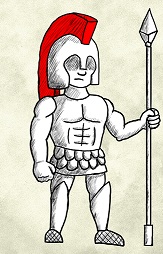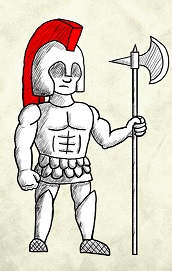This section is written for people with less than a year experience, or new to certain weapons systems. It’s just my opinion and observations, like everything else on the site, I appreciate constructive criticism.
Another way to think of the different weapons platforms that are used, is to think of them as classes, in the same way classes of ships have different roles. If you want a coast line bombarded before an invasion, sure you can send a couple of cruisers and with enough time and ordnance, youll get the job done, but why not send a battleship; it’s best equipped to do that. Or maybe think of it as classes in RPGs, you want someone to be able to take hits while you deal damage? Bring someone with a shield to complement your spear.
Final note: I use terms like OpFor meaning Opposing Force rather than Enemy, points or elimination rather than Kill and I refer to troops based on their weapons.

Shields
Calontir has a storied shieldwall tradition that has been re-lived in recent Gulf Wars. The shieldwall IS the Calontir army. Tremendous time and resources are poured into it, the training of the army centers around it, and great tales are made from it. To that end, we will cover some major points:
1) Primary Shield
Anyone with a Primary shield: Scutum, Scutari or any shield that covers your entire body without needing to move the shield. Generally whether experienced or not, the members of the line should but not necessarily be tall, big or both. They will need to crush any charges, sustain constant arrow fire, spear thrusts and attempts to pull away their shields.
There’s a good reason why everyone starts on the shield wall. If you cannot master the basic role of being on the wall, you are unlikely to do well no matter what weapons platform you eventually want to fight the most in. That brings us to the main thing you need to do on the the shield wall
Don’t Die: Sounds so easy doesn’t it? What you may not be aware of is that some of the most experienced members of the Opposing Force are gunning for you. Archers and spears are more often than not the ones who will wait for you to take a peak, glance over to one side for too long, or worse, think the “real” battle is off to the otherside of the field. In melees, archers can strike across great distances. You didn’t drive 12 hours to get sniped, be aware at all times. There is no single threat that deserves your attention at the expense of all others
So why are all these people hunting you? Very simple and brings us to the second function of your role.
Protect what’s behind the wall. That’s your fellow shield troops, spears, polearms, greatswords, greataxes. If you die, they are certainly next. Anyone without a shield has almost no chance of protecting themselves against archers. A couple of weekend warrior archers (hyperbole: no offense archers) will make short work of an entire squad of knights yielding spears.
And what about Calontiri archers? Glad you asked: one of the best things front line shields can do is point out OpFor archers. A front line in melees can easily be two dozen sets of eyes or more that cover the entire battlefield, thats alot of intel going to waste. Provide your archers with information on the position of those OpFor archers. Speak to fellow shields to let them know to watch for archers to be made aware of them. Provide cover to your archers so they can attack and withdraw safely. [Thanks Nahama!]
In addition; once you go down, that’s a hole in the shield wall, vulnerable to pulse charges or a full on concentrated charge. That’s all it takes to end a battle.
A note on shield troops placed on the flanks, you need to be on the lookout for flanking attempts. When you see them, call them out, make sure you get at least another set of eyes on that person, preferably you get the attention of someone that can run them down, but do not leave your position to pursue them, if you leave your position, you’re taking the flank with you.
2) Auxiliary/Secondary shields: These troops have shields but their shields are too small to be on the front line, at least initially. These troops will fill in for when a primary shield is taken out, a smaller shield is preferable to someone with no shield. (Please don’t bring a buckler). These troops will also act as a quick reaction force, whether to stop a flank attempt by the OpFor, or a flanking command is given, they should also be some of the quickest troops in the army.
Oh and if you’re left handed, and notice the Calontiri on the left most flank is right handed, ask the commander to let you take that position, he is unlikely to say no, and the right handed shield standing there is unlikely to say no. And of course reverse goes for the other flank and also other situations that call for it; eventually, you’ll want to incorporate practicing with your left hand. Any left handed person is likely to eventually go down, it would be great if whoever took their spot could also keep a shield in their right hand when stepping in for them
Finally, the final feature of this role: Charging. There’s a couple different types of charges, the first is the piercing charge where you are to push beyond their shield line and keep going until you are neutralized. The other is a pulse charge, meant to attempt to disrupt their lines, allowing the commander to spot weaknesses and might even follow up with a piercing charge.

SPEARS:
The Artillery: They will be taking the most shots at the OpFor and therefore score the most points, peel the most shields and so spears are in the hands of the most experienced fighters. And yes, the primary and some say, sole role of the spears is to take out OpFor troops. You’ll need stamina, hand eye coordination, tactical as well as strategic knowledge and be able to listen and give commands to your partner whether its a shield or another spear.
You need to practice your shots, many times, you will be firing at people you aren’t directly looking at. Your eyes must constantly be moving, a shield lowering for an instant, or a shield too high, that might be your only chance, if you miss it, you can be sure that shield will do better at defense next time.
You must be on the offensive constantly, but do not waste your energy blindly firing at shields, you must either be firing for a high percentage shot, or maybe a distracting shot for your partner to get the point. No matter your stamina level, if you are standing there seeing shots become available and you don’t take them because you are too tired, that’s your red flag to get out of the line and let a fresh pair of arms and eyes take their shots. Make your exit of the field orderly and your replacement nearby, someone with a spear on the defensive is an elimination waiting to happen.
And yes, also train in your offhand, you’ll come across many situations, especially bridge battles where you are on the offhand side and so you must be able to fire with that hand if you want to be effective. Standing there fumbling with the spear, worried about clashing elbows with the spear next to you, not taking shots, then effectively, you aren’t there.

Polearms/Great Axes/Great Sword:
The medium range weapons platform, polearm is slightly better at 6 or 7.5 feet generally speaking as Great Axes don’t thrust, inside of that Axes have a slight advantage as their deeper striking edges can cut around a corner/shield/shaft and make contact with you.

Greatsword is a bit more popular at 6 feet as it can thrust like a spear or polearm, but has a much longer striking surface so it gives it a slight edge against polearms and axes at close range. When I say “slight” edge I mean slight. Don’t go into a fight against someone with these other weapon systems and think this is going to be an easy win. I am speaking in general terms and it’s an advantage if you fight someone at the same skill level.
All these platforms should be 2nd line units that go to work when OpFor charges or otherwise come into range, begin to drop shots on them, exposed limbs, parts of helmets, etc. This is where these troops get most of their points.

Also when a counter flank team is sent to engage flankers, and you see its 2 shields engaging a couple spears, you’ll want to back up your shields quickly.
As you are on the 2nd line, when not engaged, it’s useful to place your weapons flat side on your allies to cover exposed parts of shield troops, let them know what you’re doing, and call out when OpFor wallops your weapon which then hits your teammates helmet or other body part. A simple “don’t move, that was me” will do.
And yup, you should also practice offhand, and not just for bridge battles, because like spears, firing offhand (left handed) is naturally advantageous when against another polearm (right handed) as your straight shot to their center has much less traffic in its way